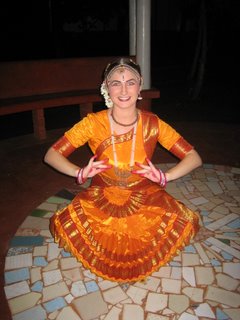Karimgunj formed around us after a solid six hours of bumpy roads and ruckus honking (after all the months I’ve spent in India, I have yet to condition myself to the strident noise of the streets and highways; Indian horns, unlike their American counterparts, are turn signals, passing alerts, warnings of nearness, and location markers and, as such, are a constant backdrop to driving). Our traveling seminar was coming to a close, and this was to be our last stop on our tour of northern
We had been slowly acculturated to the lifestyle we would be met with while in Karimgunj. Our seminar leader has an impressive forty years experience of living in and researching the village, and her advice was supported with reading material and shorter visits to a village in Rajasthan and a relocated village family in
The Brahmin family whose veranda (read: home for the water buffalo) we parked our car in contained three of the five English-speakers that I met in the village, two of which were fluent and one of which had a vocabulary only slightly more workable than the French I retained from high school. We were shown to our string cot beds, introduced to the family, and shown all around while the father proudly pointed out how well their electricity was working (it worked all day, then gave up for the rest of our stay). Let me just say: you know that something serious has happened to you when you take stock of your bathroom facilities (a squat latrine flushed by pouring water down the bowel), note the dead mouse in the corner being slowly ripped apart by a horde of ants, and exalt that this set-up is really very pleasant.
I came to India to experience something new and different, something radical and jarring; as my days here move towards their conclusion, I realize that I have certainly gotten that and a lot more. Not to be Aladdin about things, but it’s pretty much a whole new world over here. I’ve had a lot of time to sit around and collect mosquito bites. I’ve accustomed myself to the dismal quality of Indian bathrooms (now even squat toilets basking in a swamp of unknown fluid have become useable), and I’ve accepted that I’ll always have to strategize if I want to ply a few minutes worth of hot water from my shower. I can walk down the street and dodge cows, wild dogs, and their excrements without batting an eye. “Backwoods farm” and “thriving metropolis” have become interchangeable in my visual vocabulary. In short:
Until, that is, the village happened. When we first toured the village, a huge throng of schoolchildren trailed us as we walked and engulfed us whenever we stopped to watch something or meet someone. Later, these same children surrounded me to teach me Hindi from what I’m sure was the equivalent of a kindergarten reader. The family’s eldest daughter spent hours applying henna to my hands and feet, we spent nights playing marathon games of Safari Rummy by the light of a gas lantern, and the little girl next door—my favorite girl in the village—found me whenever I left the house, grabbed my hand, and stared up at me with the biggest and happiest smile that I have ever seen. A world like this would never exist in




























